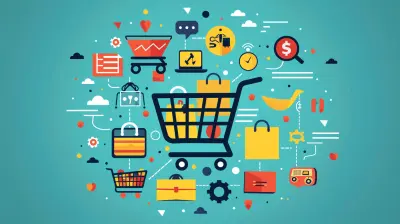How to Create a Seamless Omnichannel Experience
23 July 2025
Welcome to the magical world of omnichannel experiences — aka the holy grail of modern business strategy. If you’re still confusing “omnichannel” with “multichannel,” take a deep breath, grab yourself a coffee (or something stronger — no judgment), and settle in. We’re about to break this down and even sprinkle in a bit of sarcasm, because, let’s face it, this topic sounds way too dry without it.
We’ll navigate through the maze of customer touchpoints, digital platforms, and branding fluff to show you how to actually build an omnichannel experience that doesn’t make your customers want to yank out their Wi-Fi routers in frustration.
So, buckle up. Let’s get into this messy-yet-marvelous world of seamless customer journeys.
Wait…What the Heck Is an Omnichannel Experience?
Picture this: You’re shopping for new running shoes on a brand’s app while pretending to listen during a Zoom call. You find a pair, add them to your cart, but get distracted by your dog chewing something that definitely shouldn’t be chewable.Later, on your laptop, you swing by the brand’s website. Boom — there they are, your perfect shoes, still in your cart, waiting for you like a clingy ex. The next day, you walk into their physical store, and the sales rep already knows what style you were eyeing.
Creepy? Maybe. Convenient? Absolutely.
That, my friend, is omnichannel magic. It’s like the universe of customer service conspiring to give you a smooth, unified experience across every single channel — mobile, web, social, physical stores, smoke signals, whatever works.
Not to Be Confused With Its Awkward Cousin: Multichannel
Multichannel is like juggling flaming swords blindfolded — you’re on multiple platforms, but they’re not really talking to each other. So your customer’s app experience has no clue what happened on their email journey or in-store visit. Total chaos.Omnichannel, on the other hand, is the synchronized swim team of customer engagement. Everything’s connected, everyone’s on the same page, and the user can jump between channels without feeling like they entered a different universe.
Why Should You Care? (Seriously)
Let’s cut to the chase: customers expect convenience. We’re spoiled. Blame Amazon, or Netflix, or your favorite food delivery app that even remembers your extra guac preference.If you're not offering a seamless experience, you’re basically inviting your customers to ghost you for a competitor who is.
Here’s what you’re missing out on without omnichannel wizardry:
- Higher customer retention (people like it when things just work)
- Increased lifetime value (happy customers spend more — shocking, right?)
- Better brand perception (you look fancy and futuristic)
- Improved data insights (because piecing together buyer behavior shouldn’t feel like solving a true crime documentary)
Still not convinced? Keep reading. We’re just warming up.
Step 1: Know Thy Customer (Seriously, Stalk Them…Legally)
If you're trying to create an omnichannel experience without understanding who’s on the receiving end, it’s like throwing a surprise party with zero clue who’s coming. Are they into vegan cupcakes or whiskey shots? You gotta know.Create Customer Personas
No, these aren’t the Sims. Think of them as cheat sheets for your key customer types — including their pain points, preferences, and favorite cat memes. Once you get into their heads, you can tailor each channel to feel like home for them.Map the Customer Journey
This is where you draw out every place your customer interacts with your brand — from Instagram ads to your chatbot that gives suspiciously vague answers. Sit down, grab some sticky notes, and plot the whole ride from “just browsing” to “take my money.”
Step 2: Marry Your Channels (Yes, Forever)
Communication is everything in relationships — including the one between your channels.Centralize Your Data
Your POS system, CRM, app, website, email campaign tool, and that piece of paper the intern scribbled customer feedback on — they all need to start talking. Use integrated platforms like a CRM that plays nice with your e-commerce tools and customer service software.Pro tip: Cloud-based systems are your BFFs here. They sync data in real-time without having a mental breakdown.
Unify Your Brand Voice
Your brand voice should be like a lovable rom-com character — consistent, relatable, and memorable. Whether a customer is DM’ing you on Instagram or reading an email promotion, they should feel like they’re chatting with the same person (and not an identity-shifting robot).Step 3: Optimize Every Channel Like a Boss
Don’t just have channels for appearances. Nurture them. Feed them good content. Give them proper homes (aka, user-friendly design).Mobile (Because Everyone’s Glued to Their Phones)
If your mobile site takes longer to load than a 90s dial-up connection, you’ve already lost. Speed and responsiveness are non-negotiable. Also, make sure your mobile app doesn’t scream “1998.”Email (Still Not Dead)
Despite what TikTok teens think, email is alive and thriving. Personalize it. Segment it. Make it smarter than “Hey [First_Name], big sale!”Offer product recommendations based on past behavior, not generic “hot new items.” Nobody wants to feel like an algorithm had a mental breakdown.
Social Media (Where Your Brand Gets Judged)
Your social channels aren’t just for memes and embarrassing throwbacks. They’re full-blown customer service hubs now.Respond to DMs like a human (not a bot from 2007), and keep the content consistent. Yes, that includes your tone AND visuals.
Step 4: Make Transitions Seamless…Like Butter
Picture this: Your customer adds a product to their cart on mobile, and when they switch to desktop, it’s STILL THERE. Wild stuff, huh?This level of connectivity is what you want.
Enable Cross-Device Recognition
Use cookies, login systems, or magic (kidding, sort of) to recognize returning users and pick up where they left off. Don’t make customers re-login 12 times or re-add products like it’s Groundhog Day.Build Flexible In-Store + Online Experiences
Can customers buy online and pick up in-store? Exchange in-store after an online splurge? Return items via carrier pigeon?Okay, maybe not that last one, but convenience matters. Make the bridge between physical and digital as smooth as your favorite jazz playlist.
Step 5: Don’t Forget Customer Support (The Unsung Hero)
You’ve built a dreamy omnichannel system, and then… your chatbot says “I didn’t understand that” 47 times in a row. Cue the horror movie music.Offer Multi-Channel Support
Live chat, email, phone, text, in-app support — it all counts. And yes, your agents should have access to a unified profile of each customer so they don’t have to ask for the same information six different times.Empower Your Team
Train your employees like you’re training Olympic athletes. Because handling seamless customer experiences is no small feat. Give them access to customer insights so they can actually help instead of just faking it really well.Step 6: Test, Tweak, Repeat
An omnichannel strategy isn’t a “set it and forget it” turkey cooker. You gotta keep testing and optimizing.Analyze the Data (Without Falling Asleep)
Look at conversion rates, bounce rates, cart abandonment rates, and other fancy metrics. Where are users dropping off? Where are they thriving? Pretend you're Sherlock Holmes with Wi-Fi.Gather Real Feedback
Ask your customers what works and what doesn't. Yes, actually ask. Surveys, NPS scores, or just good ol' DMs — they’ll tell you if that fancy new chatbot is actually helpful or just a glorified FAQ.Step 7: Future-Proof Like a Fortune Teller
Tech changes faster than your weird uncle’s political views. So keep your finger on the pulse.Embrace AI (But Don’t Go Full Skynet)
Use AI for personalization, predictive analytics, and yes — smarter chatbots. But always have a human backup. Nothing screams “we don’t care” like an AI loop of generic responses.Stay Agile
Your strategy should be flexible enough to adapt to new platforms, new expectations, and whatever else the marketing gods throw your way (looking at you, metaverse).Final Thoughts: The Omnichannel Gospel
Creating a seamless omnichannel experience isn’t just a trendy buzzword to impress people on LinkedIn. It's how you stay ahead in a world where customers expect brands to read their minds — or at least remember their purchase history without acting like it’s national security.So if you’re still treating each channel like its own island, maybe it’s time to put away the stone tablets and join the modern marketing movement.
Connect your data, unify your voice, treat customers like actual humans, and update that dusty CRM. You got this.
And remember, omnichannel isn’t about being everywhere. It's about being everywhere that matters, and doing it in a way that makes your customer think, “Wow, that was easy.”
Now go forth, omnichannel warrior. The seamless journey awaits.
all images in this post were generated using AI tools
Category:
Customer ExperienceAuthor:

Matthew Scott
Discussion
rate this article
1 comments
Ardyn McNeil
Seamless omnichannel? It’s not rocket science! Just remember: your customers deserve a smooth ride, not a bumpy rollercoaster. Get your act together or risk losing them to your competition. Simple as that!
August 15, 2025 at 12:42 PM

Matthew Scott
Absolutely! Prioritizing a smooth customer journey is key to retention. Let’s ensure our strategies reflect that commitment. Thank you for the reminder!


